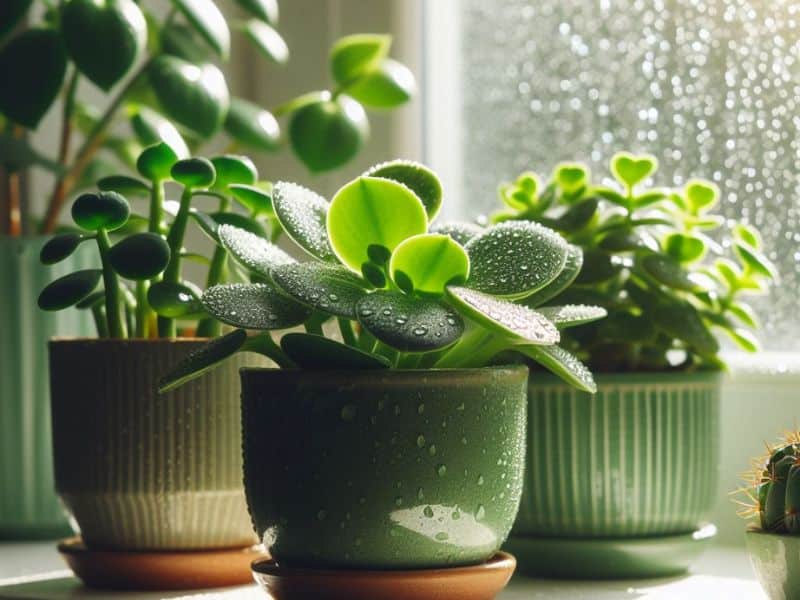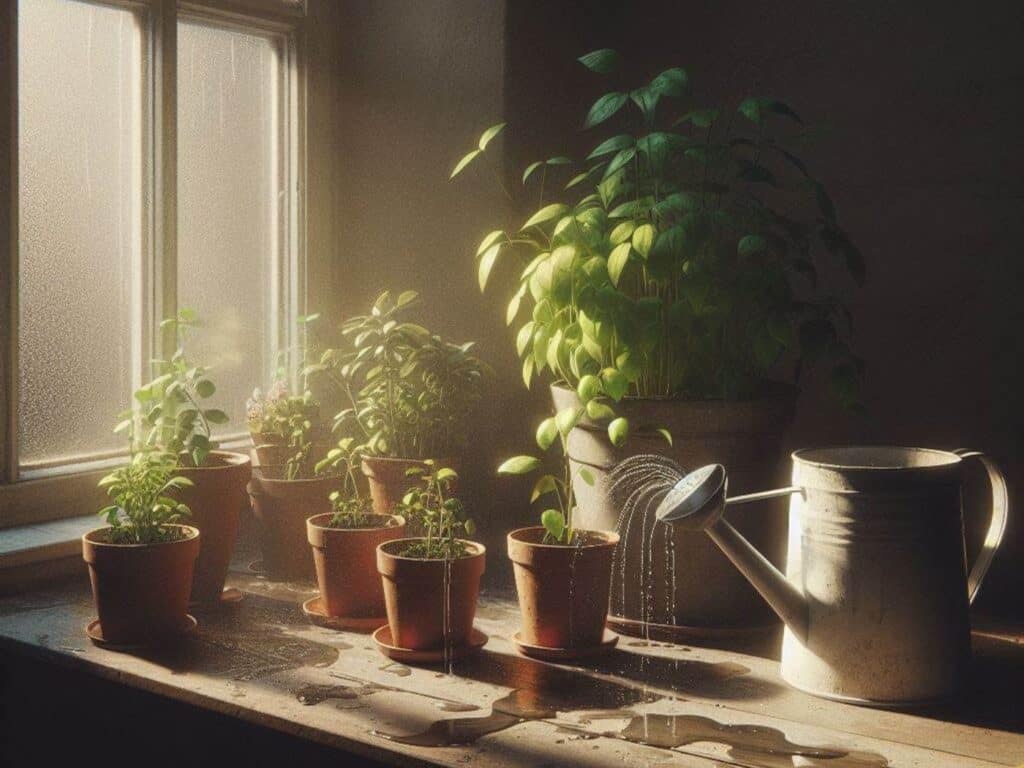Caring for plants can sometimes feel like walking a tightrope, especially when it comes to watering. Strike the right balance, and your plants thrive, showcasing their lush, vibrant leaves and blooms.
Tip too far one way, however, and you’re left with the telltale signs of distress. Overwatered and under-watered plants both suffer, but in ways that may well not be immediately apparent to the untrained eye. Understanding the difference is crucial, not just for the health of your plants but for your peace of mind as a gardener.
If you’ve ever found yourself second-guessing your watering routine, you’re not alone. Many plant enthusiasts struggle with this very issue, unsure if they’re providing too much or too little water.
This article aims to demystify the signs of overwatering and under-watering, helping you identify what your plants are really telling you. With the right knowledge, you can adjust your care practices and foster a thriving green space.
Recognizing the Signs of Overwatered Plants

Watering plants feels like a simple task, but get it wrong, and it’s a slippery slope to unhappy greenery. Overwatering is a common pitfall, but with a keen eye, you can catch the signs before it’s too late.
Wilting Leaves Despite Moist Soil
You’d think wilting means more water, right? Wrong. If the soil’s damp but those leaves droop like they’ve watched a sad movie, you’re dealing with too much H2O. Plants are dramatic that way, showing signs of distress even when they’ve had more than enough to drink.
Root Rot and a Persistent Damp Smell
Stick your nose near your plant’s pot; if it smells like a swamp, you’ve probably overwatered it. Root rot is the silent killer of many houseplants, and that musty stench is its calling card. This isn’t a fragrance you’d want lingering around, signaling it’s time to cut back on the water.
Mold Growth on the Surface of the Soil
Spotting a fuzz-like growth on the soil’s surface? That’s mold saying hello, courtesy of too much moisture. Besides looking uninviting, it indicates your plant is sitting in more water than it can handle. A sign to adjust your watering habits pronto.
Yellowing and Brown Leaves That Feel Soft and Squishy
Leaves turning yellow or brown with a soft, squishy texture are the plant world’s way of saying, “Help, I’ve had too much!” Unlike the crisp nature of healthy leaves, these symptoms scream overwatering. It’s a clear cue to reassess your watering routine and give your plant a chance to dry out.
Identifying Symptoms of Under Watered Plants
Transitioning from the tell-tale signs of overwatering, understanding the symptoms of under watering plants is crucial. Let’s break down the key indicators that your green friends may well be thirsty.
Dry and Crispy Leaf Edges
When you notice the edges of leaves turning dry and crispy, it’s a classic cry for hydration. Unlike overwatering symptoms, these signs demonstrate a lack of moisture reaching the foliage, leading leaves to slowly lose their lushness and turn brittle.
Slow Growth and Smaller Leaves
Plants struggling with water scarcity often exhibit stunted growth. If your plant’s leaves are not only smaller than usual but also experiencing slow growth, it’s time to reevaluate your watering schedule. These conditions make it challenging for plants to thrive and expand.
Soil Pulling Away from the Edges of the Container
A surefire sign of dehydration in your potted plants is when the soil begins to contract, pulling away from the container’s edges. This gap indicates that the soil is too dry, failing to provide your plants with the moisture they desperately need.
Drooping Leaves That Appear Dry and Brittle
Don’t be fooled; drooping leaves aren’t always a sign of overwatering. If they appear dry and lack elasticity, accompanied by a brittle texture, your plant is likely under watered. This symptom shows the plant’s inability to maintain its natural vigour due to inadequate water intake.
Recognizing these signs early on empowers you to take quick action, ensuring your plants remain hydrated and healthy. An attentive eye and timely intervention can transform a parched plant back into its vibrant self.
Causes and Contributing Factors
Overwatering: More Harm than Help
Overwatering happens more often than you may well think, usually stemming from a kindhearted but misguided attempt to care for plants. It’s the result of too much enthusiasm, leading to frequent watering schedules that exceed the plant’s needs.
Poor drainage also plays a crucial role; if water cannot escape the pot, roots are left sitting in moisture, which can spell disaster. Checking the drainage capabilities of your pots and moderating your watering routine can prevent the adverse effects of overwatering, such as root rot and fungal growth.
Under Watering: Neglect and Environmental Stress
On the flip side, under-watering typically springs from neglect or a misunderstanding of a plant’s hydration needs. Busy schedules or a lack of understanding about the signs of thirst can lead to prolonged dry spells. Environmental factors equally contribute to under-watering issues.
High temperatures, low humidity, or pots that are too small can increase water consumption or evaporation rates, leaving plants high and dry. Monitoring your plants’ environment and adjusting your watering based on their feedback—yes, plants give feedback too, in their way—is key to avoiding the pitfall of under-watering.
Best Practices for Watering Your Plants
Assessing Your Plant’s Specific Needs
Figuring out what your plant craves in terms of water involves a bit of detective work. Each species has its own preference, influenced by its native habitat.
For example, succulents revel in dry conditions, while ferns bask in moisture. Start by researching your plant’s background. If it’s a tropical darling, it’ll likely yearn for more frequent sips than its desert-dwelling counterparts.
Techniques for Appropriate Watering
The art of watering goes beyond just pouring water over the soil.
First off, timing is key; early morning is ideal. This gives plants time to drink up before the heat of the day but also allows excess water to evaporate, reducing the risk of fungal diseases.
Secondly, focus on soil saturation over frequency. A good soak that reaches the roots encourages them to grow deeper, creating more resilient plants. Avoid just wetting the surface, which can lead to shallow rooting and weaker plants.
Tools to Monitor Soil Moisture
Don’t rely on guesswork to determine soil moisture. Tools like moisture meters can provide a direct read of water levels, letting you know when to grab the watering can. Another simple yet effective method is the finger test.
Stick your finger about an inch into the soil; if it’s dry, it’s time to water. For those who prefer a more hands-off approach, self-watering pots or soil moisture sensors connected to smartphone apps can automate the process, leaving no room for error.
Addressing and Recovering from Water Issues
Salvaging Overwatered Plants
Got a plant that’s had a bit too much to drink? First off, stop watering immediately and give it a chance to dry out. Check the pot for adequate drainage; if it’s lacking, consider repotting the plant into one with better drainage holes or adding a layer of pebbles at the bottom to help water escape.
For plants already showing signs of root rot, trim away the rotten roots carefully before repotting in fresh, well-draining soil. This may well feel like plant surgery, but it’s often necessary to save your green friend!
Reviving Under Watered Plants
On the flip side, if you’ve neglected your plant’s cries for water, recovery begins with a gentle soak. Place the pot in a sink filled with a few inches of water and let the soil rehydrate from the bottom up. This method helps the soil absorb moisture evenly without causing further stress.
After the topsoil feels moist, remove the plant from the sink and allow any excess water to drain away. Moving forward, adjust your watering schedule to meet the plant’s needs, based on its specific habitat. Remember, consistency is key to helping your plant bounce back.
Prevention Tips for Optimal Plant Health
Keeping your plants thriving involves more than just giving them water. It’s about understanding their specific needs and creating an environment where they can flourish.
Understanding Your Plant’s Natural Habitat
Think of plants as tourists from their native lands, each with its own preference for climate and care. Succulents, for example, are the camels of the plant world, storing water in their thick leaves and preferring dry conditions.
Conversely, ferns thrive in the moist, shady floors of forests, craving higher humidity and consistent moisture. By replicating these conditions as closely as possible, you create a comfort zone for your plants, greatly increasing their chances of not just surviving, but thriving. Dive into the origins of your green friends, acknowledging their natural habitat plays a crucial role in their health.
Regular Monitoring and Adjustments
Consistency? Yes. Autopilot? No. Regular check-ins on your plants are essential. Use moisture meters or the good old finger test to check the soil’s moisture level; this will help you avoid over or under-watering.
Adjust your watering strategy based on the season. Plants typically need more water during the warm growing season and less during the colder months. But remember, indoor heating can dry plants out faster in winter, so keep an eye out.
Also, rotating your plants can ensure they grow evenly, as most lean towards the light. This habit of adjusting care based on observation will keep your plants in peak condition, making both you and your leafy companions happier in the long run.
Up next: Overwatered vs Under Watered Grass: Balancing Your Lawn’s Hydration







